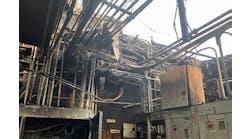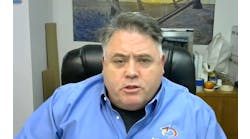Kimberly-Clark rebuilds tissue machine despite COVID-19
“We planned to check out the new equipment in March 2020, with people coming from different parts of the U.S. and other countries. COVID-19 changed all that.” Kimberly-Clark’s Gabriel Pacheco described how his team—and their suppliers—overcame pandemic travel restrictions to start up a fully rebuilt tissue machine.
The show must go on, especially when you're making toilet paper and facial tissue. It's well known that consumers everywhere have needed more paper tissue during the COVID-19 pandemic because they're working and staying home much more. However, if you're a manufacturer like Kimberly-Clark, and you were already rebuilding an old tissue machine to meet increased demand, how do you overcome an ironic, Catch-22, twist of fate like the pandemic halting your rebuild of that very same machine?
Kimberly-Clark operates several U.S. mills, but it had a machine that had to be rebuilt at its plant in Mobile, Ala. It was installed in 1965, and had reached the end of this useful lifecycle. It had GE drives controlling its large motors, and a Honeywell TDC 2000 distributed control system (DCS) and Modicon Quantum programmable logic controllers (PLCs) for its distributed I/O points.
"All of these systems were obsolete, and they'd just limped along for a long time," said Gabriel Pacheco, electrical engineer and project lead, Kimberly-Clark Professional. "It was hard to find replacement parts and the technical knowledge for maintenance."
Pacheco presented his team's experience in "Delivering a new tissue machine in a COVID-19 world" this week at the Process Solutions User Group virtual event held as part of Rockwell Automation Fair at Home.
Rebuild benefits and logistics
Tissue machines typically include a wet end, where the pulp goes through different paths, and a dry end, where the tissue paper is rolled up. The new machine was designed to provide a unified view and control of components from multiple OEMs.
Pacheco reported that Kimberly-Clark's project would have many other advantages, including a common, integrated drive-control platform and safety controls, which would improve reliability and uptime, and reduce the costs of running the drives.
"It also gives us broader access to maintenance resources, including remote support, which will also reduce support and licensing costs," said Pacheco. "This was not just an upgrade; it was a complete rebuild. We took the old machine and its drives down, and put in all-new drives and controls. There were some challenges to doing this, such as the location of the old tissue machine in the middle of other machines. This meant we had to reroute many other connections at the same time, so we could keep those other machines running."
Pacheco added that his team also wanted to make the new machine's systems and drives easier to use for their operators, and coordinate the new drives on the main machine with many existing, smaller drives on support equipment. Another significant challenge was that Kimberly-Clark's team at the Mobile plant had to collaborate on the rebuild with OEMs from Italy, Sweden, Finland and Canada, as well as with drives and DCS groups from Rockwell Automation.
Phases and primary components
The main phases of the tissue machine rebuild project included demolishing old equipment, including its burner house and basement levels, and then building new structural sections to support its new mechanical and electrical systems. After that, construction and engineering checkouts would be followed by a process control check out before startup.
"We also had to replace unit substations to provide power to the main drive. One unit sub is on the wet end, one is for the dry-end drives, and a third powers the new electrical room," explained Pacheco. "We also replaced nine drives with Rockwell Automation PowerFlex 755 drives that were split between the wet and dry ends, and added a couple of HMIs (human-machine interfaces) that were integrated with the main DCS system. The previous TDC 2000 controls were replaced by Rockwell Automation ControlLogix V.30 controllers with its PlantPAx Process Library. We're also using Rockwell Automation FactoryTalk View and FactoryTalk Historian software as well as thin clients."
Pacheco added that kitchen-rail safety functions on the new machine are also handled by ControlLogix and new safety relays, which are integrated into the overall DCS system. Likewise, the old burner management system (BMS) that had Honeywell and Modicon controls were replaced by a new burner room and BMS with a safety PLC and HMI that are also integrated into the new DCS. Split between the wet and dry ends, this new BMS includes servers for data collection, FactoryTalk Historian, thin clients, scanners and HMIs. They're all networked on one of the plant's two networks for critical or non-critical communications, which also link up other racks, drives, unit substations and routing devices.
Push back against the pandemic
Pacheco reported that the tissue machine rebuild was authorized in January 2018, started its shutdown and demolition in September 2019, and was scheduled to start up in April 2020. However, as with so many other endeavors, it was derailed by the COVID-19 pandemic.
"The old machine produced its last roll of tissue in September 2019, demolition and construction lasted six months, and we planned to check out new equipment in March 2020 with people coming from different parts of the U.S. and other countries. COVID-19 changed all that, and we had to come up with a new timeline," said Pacheco. "We had to implement social distancing for the equipment checkout and startup crews onsite. Then, on April 3, we had a COVID-19 case reported in another area of the mill, and all of our machine suppliers had to go back home. This made it seem like our original April 13 startup wasn't going to happen."
Despite this apparently crippling setback, Pacheco reported that his team and their supplier partners figured out how to set up remote support, which would allow everyone to see the machine’s components and continue their efforts. "We installed cameras, wireless access points and cellular hotspots, and added iPads and other tablet PCs with headset tie-ins, so onsite people could get technical help," explained Pacheco. "We even tested gaming headsets, and found the most useful one for us was a 3M headset with Bluetooth that could be inserted into earmuffs, which canceled out noise from the machine, and allowed users to hear remote people clearly."
Pacheco added that the checkout/startup crews and their remote colleagues also used PTC's Vuforia augmented reality software to illustrate points on captured images, and also collaborated by using Skype and Microsoft Teams video conferencing services.
"The cameras on the tablets and support tools let all the different participants from Kimberly-Clark, our OEMs, Rockwell Automation and others see what was going on and share with one another," said Pacheco. "We completed commissioning on April 20, and on May 9, we were making paper again."
The editors of Control, Control Design and Smart Industry are providing coverage of Automation Fair At Home, bringing you breaking news, innovations and insights from the virtual event. Once Automation Fair At Home is over, the editors will put together an event report featuring the top news. Pre-order your copy today.







